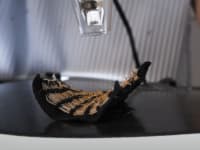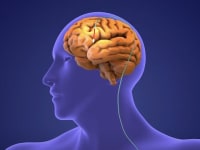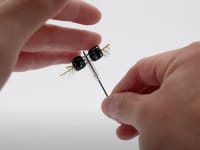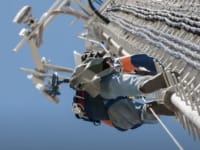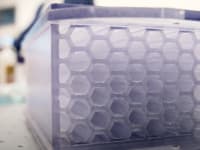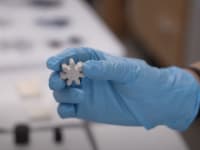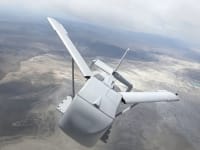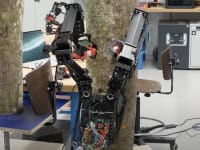61
194
-1
30
30
Question of the Week: Electronics & Computers
Will Our Bodies Power Our Everyday Electronics?
One of the top INSIDER stories of 2021 included a “wearable microgrid” that harvests energy from motion and sweat to power electronics. (Read the 2021 INSIDER story.)
Question of the Week: Transportation
Will Automotive and Aerospace Industries Adopt Self-Healing Composites?
An INSIDER story this month highlighted how researchers from RPI and the University of Washington have created a composite that reverses fatigue damage — after applying some heat.
Question of the Week: Materials
Will Mars Habitats Be Made from Blood?
Transporting a single brick to Mars is extremely expensive. The high cost presents a challenge for those planning the future construction of a Martian colony.
Question of the Week: Mechanical & Fluid Systems
Will Spinning Magnets Clean Up Space Debris?
Our lead story today highlights an effort from the University of Utah to use spinning magnets – and robots – to someday retrieve scraps and bring them to a decaying orbit.
Question of the Week: Materials
Can Borophane Beat Graphene?
A Tech Brief in our November issue highlights a new material that’s super-thin and super-strong. By combining hydrogen with an atom-thick sheet of boron known as borophane, researchers from Argonne National Laboratory (ANL) have created a potential alternative to the breakthrough 2D material graphene. The Argonne...
Question of the Week: Packaging & Sterilization
Will Coatings Reduce Food Waste?
Today’s lead story highlighted an egg-based coating that extends the shelf life of fruits and vegetables.
Question of the Week: Energy
Will We Use Solar to Power Our Devices Indoors?
Solar or photovoltaic (PV) cells fixed to roofs convert sunlight into electricity. An October Tech Brief highlighted a spin on this traditional idea of solar.
Question of the Week: Materials
Will Technology Help to Reduce Plastic Pollution?
Our October Q&A in Tech Briefs highlighted an achievement from Professor Aaron Sadow of Ames Laboratory in Iowa. Sadow’s chemical process produces valuable biodegradable chemicals from discarded plastics, which are then used as surfactants and detergents in a range of applications.
Question of the Week: Energy
Will We Ever Charge Our Cars (As We Drive)?
Cornell Engineering Professor Khurram Afridi wants you to be able to power-up your vehicle simply by changing lanes and driving over a charging strip.
Question of the Week: Manufacturing & Prototyping
Will Laser Cooking Catch On?
Our lead story today looked at a cutting-edge way to prepare food: Laser cooking.
Question of the Week: Energy
Will Our Buildings Store Energy Like Giant Batteries?
Our September issue of Battery Technology highlighted rechargeable cement-based batteries that can be utilized as functional concrete. The achievement from Chalmers University of Technology, according to the battery’s developers, lays the groundwork for entire buildings that could someday...
Question of the Week: Electronics & Computers
Will Stretchable Smartphones Catch On?
Our “5 Ws” feature this month highlighted skin-like electronic circuits being developed at Virginia Tech.
Question of the Week: Electronics & Computers
Will ‘Charging Rooms’ Catch On?
Our Question of the Week focuses on today’s lead story – the creation of an aluminum test area that wirelessly powered lamps, fans, and cell phones.
Question of the Week: Mechanical & Fluid Systems
Would You Use a ‘Cold Tube?’
Our August issue of Tech Briefs highlighted a technology that offers an energy-efficient alternative to the air conditioner: The Cold Tube.
Question of the Week: Software
Does A.I. Need to Be Able to ‘Imagine?’
An INSIDER story this month highlighted efforts from USC researchers to train artificial intelligence to imagine the unseen. The artificial-intelligence system uses the attributes that it "knows" to then think up a never-before-seen object.
Question of the Week: Software
Could Digital Twins Be Used on ‘Any System?’
An INSIDER story this month highlighted efforts to use sensors to improve the virtual design model known as a digital twin.
Question of the Week: Robotics, Automation & Control
Will ‘Air Power’ Boost the Use of Soft Robots?
Our second INSIDER story today highlighted William Grover and his UC Riverside team’s efforts to swap electronics with air.
Question of the Week: Energy
Will ‘Sweat Power’ Make Wearables Mainstream?
Engineers at the University of California San Diego developed a thin, flexible strip that can be worn on a fingertip and generate small amounts of electricity when a person’s finger sweats or presses on it. (Watch the demo on Tech Briefs TV.)
Question of the Week: Electronics & Computers
Will Interstate Power Coils Charge Electric Vehicles as They Drive?
Our “Q&A” article in the July issue of Tech Briefs highlighted the work of Dr. Burak Ozpineci from Oak Ridge National Laboratory. Ozpineci and his team are building a wireless power-transmission system that charges an electric vehicle as it drives along the road.
Question of the Week: Energy
Will ‘Mass-Less’ Energy Storage Finally Catch On?
A July Tech Brief highlights a “structural battery” from the Chalmers University of Technology that uses carbon fiber as a negative electrode and a lithium iron phosphate-coated aluminum foil as the positive electrode. The battery works as both a power source and as part of the main...
Question of the Week: Manufacturing & Prototyping
Should Cities be More Strategic with Reflective Surfaces?
Cities around the world are adjusting – and in some cases overhauling – their infrastructure in an effort to cool temperatures in their areas. Los Angeles and New York City, for example, have adopted “grey infrastructure” efforts, like applying coatings to roofs and roads so that...
Question of the Week: Test & Measurement
Will Mobile Radar Replace the Stethoscope?
Our June issue of Tech Briefs highlighted a radar system that enables touch-free monitoring of heart sounds. A significant advantage offered by radar, according to the system’s inventors, is the fact that the values are recorded digitally and are thus not subjective, allowing human error to be...
Question of the Week: Energy
Will Better Sensors Lead to Greater Adoption of Hydrogen Power?
One of the final hurdles to hydrogen power is securing a safe method for spotting hydrogen leaks. A sensor, featured in the June issue of Sensor Technology, has a greater sensitivity than other detectors.
Question of the Week: Electronics & Computers
Will Recyclable Electronics Catch On?
Our June issue of Tech Briefs features a completely recyclable transistor from Duke University. The fully functional semiconductor is made out of three carbon-based inks that can be easily printed onto paper or other flexible, environmentally friendly surfaces.
Question of the Week: Electronics & Computers
Will Rectennas Reduce Our Need for Batteries?
Rectennas act a bit like your car antenna. Instead of picking up radio waves, however, the tiny optical devices absorb light and convert it into power. The rectenna featured in today’s top story, generated half a nanowatt – a small amount of power that its inventors hope to increase.
Question of the Week: Aerospace
Will 'Zero-Impact' Planes Take Off?
Our May issue of Tech Briefs highlighted a hybrid-electric aircraft design from MIT that, according to its creators, could reduce global nitrogen oxide (NOx) emissions by 95 percent.
Question of the Week: Materials
Will Metal-Free Batteries Catch On?
Our lead story today highlighted a metal-free battery that degrades on demand. While a cobalt-less battery has its sustainability benefits, more work will need to be done for the Texas A&M-developed technology to compete with the lithium-ion standard.
Question of the Week: Materials
Will ‘Living Materials’ Catch On?
Our lead story today highlighted the possible applications for a "living material" made from microalgae and cellulose.
Question of the Week: Aerospace
Will We See Human Exploration on Mars by 2040?
An INSIDER story last week highlighted another recent achievement on Mars: A rover instrument known as “MOXIE” created oxygen from the Martian atmosphere. The NASA-led demonstration is a first step toward human presence on the Red Planet, according to MOXIE principal lead Michael Hecht.
Top Stories
Blog: Manufacturing & Prototyping
2025 Holiday Gift Guide for Engineers: Tech, Tools, and Gadgets
INSIDER: Research Lab
Scientists Create Superconducting Semiconductor Material
Blog: Software
Quiz: Materials
Blog: Aerospace
Tech Briefs Wrapped 2025: Top 10 Technology Stories
Blog: Manufacturing & Prototyping
Webcasts
 Upcoming Webinars: AR/AI
Upcoming Webinars: AR/AI
The Real Impact of AR and AI in the Industrial Equipment Industry
 Upcoming Webinars: Motion Control
Upcoming Webinars: Motion Control
Next-Generation Linear and Rotary Stages: When Ultra Precision...
 Upcoming Webinars: Energy
Upcoming Webinars: Energy
Hydrogen Engines Are Heating Up for Heavy Duty
 Podcasts: Medical
Podcasts: Medical
How Wearables Are Enhancing Smart Drug Delivery
 Podcasts: Power
Podcasts: Power
SAE Automotive Podcast: Solid-State Batteries




